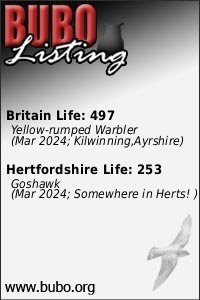I started the day up at Peninnis where I noted 6 Skylark and my first Fieldfare of the trip. I then decided to walk along the coast path towards Porth Hellick. As I was approaching Tolman Point I noticed a bird flicking about on the rocks and was pleased to find a lovely male Black Redstart. I informed others and as we were watching it someone found a female nearby.
At Porth Hellick I went to be nosey and see what the ringers had found. As I approached they were removing a Chiffchaff and below that a Jack Snipe. As Jim the ringer moved around to get it he almost trod on another that flew off to the pool. Once safely removed I quickly grabbed a couple of photos showing just how small they are. There was another showing from the hide.
Jack Snipe (not my nails!)
I left them to it and wandered off towards Carn Friars in an attempt to relocate the previous days
Wryneck near the Apple orchard maze. I scanned the fields, trees and bushes for about 20 minutes with no joy but as I started walking up the path to the farm a bird flicked up into the largest Coprosma bush and sat motionless in a gap for about 5 seconds before a
Robin pushed it off. Success, my 2nd
Wryneck of the trip.
Happy with that I headed back to Porth Hellick and had a walk around the loop. Another bird flicked up and finally I had seen a Reed Warbler this trip but again it was a 4-5 second view before vanishing. Whilst waiting for it to reappear a bird gave out a couple of single calls that I didn’t recognise but fell silent. The following day a possible Radde’s Warbler was found nearby and the recording of the call sounded very similar. Maybe next year I should brush up on scarcer bird calls before I go just incase!
At Sandy Lane I came across another Yellow-browed Warbler but it was very mobile in the wind.
Jack Snipe
Lower Moors was my final stop of the day as there’d been 9
Jack Snipe reported from the 2 hides. Again the thermal imager was deployed and I managed to see 12 from the ISBG hide and screen and missed another that had walked into the reeds and another single from the Hilda Quick hide. So definitely 13 but probably 14 birds! At the log the following day the records had been checked and the highest total on record was of 18 birds from the 5 islands in a day so my flock of 13 is the largest single group. There must’ve been 40-50 across the islands but probably lots more given how tricky they usually are to see.
Death’s-head Hawkmoth
At the log Ralph Parks brought in this beast of a
Death’s-head Hawkmoth that he’d trapped at Pelistry. One he’d been trying to catch there in 30 years of visiting the islands!



















































